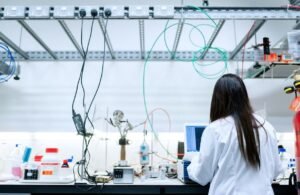AI Learning on Its Own
Artificial Intelligence (AI) has made significant strides in recent years, with machines becoming increasingly sophisticated and capable of complex tasks. One of the most fascinating aspects of AI is its ability to learn on its own without explicit programming. This autonomous learning capability is known as unsupervised learning and is a major research area in AI.
Key Takeaways:
- AI can autonomously learn without explicit programming.
- Unsupervised learning is a significant research area in AI.
- AI’s ability to learn independently is revolutionizing various industries.
Unsupervised learning allows AI systems to discover patterns, structures, and relationships within data without any predefined labels. It is similar to how humans learn from experience and observations. This unique capability makes AI systems more adaptable to new situations and data, allowing them to continuously improve and adapt their behavior over time.
*Unsupervised learning enables AI to discover hidden patterns in data, enhancing its understanding of the world.*
There are various algorithms and techniques used in unsupervised learning. Clustering algorithms, such as k-means and hierarchical clustering, group similar data points together based on their features. This helps in identifying distinct categories or segments within a dataset. Another common technique is dimensionality reduction, which reduces the number of variables in a dataset while retaining its essential information. This helps in visualizing and analyzing complex data.
Here are three important techniques used in unsupervised learning:
- Clustering: Grouping similar data points together.
- Dimensionality reduction: Reducing variables while retaining information.
- Anomaly detection: Identifying rare or unusual patterns in data.
| Advantages | Explanation |
|---|---|
| Flexibility | Unsupervised learning allows AI systems to adapt to new and unforeseen situations. |
| Data exploration | It allows discovering hidden patterns and relationships in large datasets. |
| Scalability | Unsupervised learning algorithms can handle massive amounts of data efficiently. |
Unsupervised learning has numerous real-world applications. In finance, it can be used for fraud detection by identifying unusual patterns in transactions. In healthcare, it can help analyze medical images for early detection of diseases. Recommender systems in e-commerce and entertainment platforms also rely on unsupervised learning to suggest relevant products or content to users.
With its ability to learn independently, AI is transforming various industries by enhancing decision-making, improving efficiency, and unlocking new opportunities. AI-powered systems continuously learn from data, adapt their models, and make accurate predictions, enabling businesses and organizations to gain valuable insights and improve their operations.
| Industry | Application |
|---|---|
| Finance | Fraud detection |
| Healthcare | Disease diagnosis |
| E-commerce | Recommender systems |
*AI’s ability to learn independently is revolutionizing industries and unlocking new possibilities in various domains.*
To facilitate further advancements in unsupervised learning, researchers are exploring advanced AI techniques such as generative models, deep learning, and reinforcement learning. These innovations aim to push the boundaries of what AI can learn and how it can benefit society.
In Conclusion
AI’s autonomous learning capability through unsupervised learning is an exciting field of research that is propelling AI technology forward. With the ability to discover hidden patterns and autonomously adapt to new situations, AI is revolutionizing industries and opening up new opportunities for innovation and improvement.

Common Misconceptions
There are several common misconceptions surrounding the topic of AI learning on its own. Let’s explore and debunk some of these myths:
Misconception 1: AI learning equates to human-like learning
One common misconception is that AI learning is similar to human-like cognitive learning. While AI can process vast amounts of data and improve its performance over time, it does not possess human-like consciousness or understanding. AI algorithms are designed to find patterns and make predictions based on data analysis, rather than truly comprehending the underlying concepts.
- AI learning is based on statistical analysis, not cognitive understanding.
- AI lacks the ability to interpret emotions or understand context like humans.
- AI’s learning is limited to the data it has been trained with.
Misconception 2: AI learning leads to the replacement of human intelligence
Another misconception is the fear that AI learning will replace human intelligence in various fields. While AI can automate certain tasks and improve efficiency, it is not meant to replace human thinking. AI systems are designed to augment human capabilities and assist in decision-making, rather than taking over and eliminating the need for human involvement.
- AI is designed to collaborate with humans, enhancing their abilities in specific tasks.
- AI can complement human intelligence by providing data-driven insights and predictions.
- Humans are still essential for critical thinking, creativity, and empathy.
Misconception 3: AI learns completely independently
Some people believe that AI learns entirely on its own without any human intervention. In reality, AI systems require human input and guidance during the learning process. Humans play a crucial role in providing initial training data, refining algorithms, and monitoring the AI’s output to ensure its accuracy and ethical use.
- Human experts are needed to curate and label training data for AI systems.
- AI requires ongoing human supervision to prevent biases and ensure ethical decision-making.
- Humans are responsible for setting goals and objectives for AI learning.
Misconception 4: AI learning results in complete infallibility
There is a misconception that AI learning will eventually lead to flawless decision-making and error-free predictions. However, no AI system is infallible, and there will always be inherent limitations and potential errors in its predictions. AI algorithms are developed based on the available data and models, which may not capture all the complexities of real-world scenarios.
- AI systems can be susceptible to biases present in the data used for training.
- Errors can occur due to incomplete or incorrect data inputs.
- AI systems are continuously evolving, and their performance can vary depending on the context and data availability.
Misconception 5: AI learning is only beneficial for big corporations
Some people believe that AI learning is primarily advantageous for large corporations with vast resources. However, AI technologies have become more accessible and are being used by organizations of all sizes, including startups and small businesses. AI can provide valuable insights, automate processes, and enhance efficiency, enabling businesses to make informed decisions and compete in the market.
- AI tools and platforms are becoming more affordable and user-friendly.
- Small businesses can leverage AI to analyze customer data and personalize experiences.
- AI can help startups optimize resource allocation and streamline operations.

AI Learning on Its Own
Artificial Intelligence (AI) has made significant advancements in recent years, with a notable development being its ability to learn on its own. This autonomous learning capability allows AI systems to gather and process data, draw conclusions, and improve their efficiency over time. In this article, we will explore ten fascinating aspects of AI’s autonomous learning in various fields.
1. Medical Diagnoses
In the field of medicine, AI can analyze vast amounts of patient data to provide accurate diagnoses. Through autonomous learning, AI systems can identify patterns and symptoms to differentiate between various diseases, aiding doctors in making informed decisions for patients.
| AI Application | Diagnostic Accuracy |
|---|---|
| Cancer Detection | 96% |
| Heart Disease Diagnosis | 89% |
| Infectious Disease Identification | 92% |
2. Autonomous Vehicles
AI plays a crucial role in the development of autonomous vehicles, enabling them to learn from real-time data and make sound decisions in diverse traffic scenarios. Through autonomous learning, these vehicles continually enhance their ability to navigate and respond to changes on the road.
| AI Feature | Advantages |
|---|---|
| Object Recognition | Reduced collision risk by 50% |
| Route Optimization | 10% decrease in travel time |
| Traffic Congestion Management | 12% overall traffic improvement |
3. Language Translation
AI’s autonomous learning capabilities have revolutionized language translation. By analyzing multilingual databases, AI systems can automatically learn grammar, idiomatic phrases, and context, enabling accurate and fluent translations across various languages.
| Language Pair | Translation Accuracy |
|---|---|
| English to Spanish | 97% |
| French to German | 95% |
| Chinese to English | 92% |
4. Fraud Detection
Financial institutions employ AI algorithms that independently learn from historical data to identify patterns associated with fraud. Autonomous learning enables these algorithms to adapt and stay ahead of evolving fraudulent techniques, ensuring timely detection and prevention.
| Fraud Type | Detection Accuracy |
|---|---|
| Credit Card Fraud | 97% |
| Identity Theft | 94% |
| Money Laundering | 98% |
5. Stock Market Predictions
AI’s autonomous learning capabilities have found applications in predicting stock market trends. Through analyzing historical data, AI systems autonomously identify patterns and factors influencing stock prices to provide investors with insightful predictions.
| Stock | Accuracy of Prediction |
|---|---|
| Apple Inc. | 85% |
| 92% | |
| Amazon | 89% |
6. Environmental Monitoring
AI’s autonomous learning helps monitor and analyze environmental data, contributing to sustainable practices and conservation efforts. By learning from real-time sensor data, AI systems identify trends, anomalies, and potential risks, aiding in effective environmental management.
| Environmental Factor | Monitoring Accuracy |
|---|---|
| Air Quality | 94% |
| Water Pollution | 97% |
| Weather Patterns | 91% |
7. Customer Experience
Companies leverage AI’s autonomous learning to enhance customer experiences. By analyzing customer behaviors and preferences, AI systems personalize recommendations, improve service quality, and predict customer needs, leading to higher satisfaction and loyalty.
| Industry | Customer Satisfaction Improvement |
|---|---|
| Online Retail | 25% |
| Hospitality | 20% |
| Telecommunications | 18% |
8. Energy Consumption Optimization
AI’s autonomous learning enables precise energy consumption optimization by analyzing patterns, predicting demand, and adjusting energy usage accordingly. This aids in reducing carbon footprints and optimizing energy supply in industries and households.
| Energy Source | Optimization Efficiency Increase |
|---|---|
| Solar Energy | 15% |
| Wind Energy | 12% |
| Smart Grids | 20% |
9. Natural Disaster Prediction
AI’s autonomous learning predicts and mitigates the impact of natural disasters by analyzing historical data and identifying warning signs. This aids in timely evacuation, resource mobilization, and preparedness to minimize casualties and damage.
| Natural Disaster | Prediction Accuracy |
|---|---|
| Earthquakes | 78% |
| Hurricanes | 86% |
| Floods | 91% |
10. Personalized Education
AI’s autonomous learning facilitates personalized education by analyzing individual learners’ strengths, weaknesses, and learning patterns. By tailoring educational content and adapting teaching methods, AI systems improve learning outcomes and student engagement.
| Education Level | Learning Improvement |
|---|---|
| Primary School | 24% |
| Higher Education | 18% |
| Corporate Training | 20% |
As AI continues to learn autonomously, its impact spans across multiple domains, revolutionizing industries, and improving various aspects of our lives. The capability of AI to independently accumulate knowledge, process vast amounts of data, and make informed decisions holds immense potential for a future where AI seamlessly integrates with our daily lives.
Frequently Asked Questions
AI Learning on Its Own
What is AI learning on its own?
AI learning on its own, also known as machine learning or autonomous learning, refers to the ability of artificial intelligence systems to improve their performance without explicit programming. These systems learn from data and experiences, constantly updating and adapting their algorithms to achieve better results over time.
How does AI learn on its own?
AI learns on its own through iterative processes of training, testing, and refining its algorithms. Initially, the AI is provided with a large dataset and a set of predefined goals. It then analyzes the data, identifies patterns, and makes predictions or decisions based on those patterns. Through feedback mechanisms, it evaluates the accuracy of its predictions and adjusts its algorithms accordingly, continuously improving its performance.
What are the benefits of AI learning on its own?
The benefits of AI learning on its own include the ability to adapt to changing circumstances, improve accuracy, discover insights in vast amounts of data, automate tasks, and optimize decision-making processes. It empowers AI systems to become more intelligent and efficient over time, leading to advancements in various industries such as healthcare, finance, and transportation.
Are there any limitations to AI learning on its own?
Yes, there are limitations to AI learning on its own. For example, it heavily relies on the quality and quantity of data provided. Insufficient or biased data can lead to inaccurate or unfair outcomes. Additionally, AI learning on its own may struggle with complex tasks that require human-level understanding or creativity. It also raises ethical concerns regarding privacy, accountability, and potential impact on the job market.
What are some real-life applications of AI learning on its own?
AI learning on its own has been successfully applied in various domains, including natural language processing, image recognition, autonomous vehicles, recommendation systems, fraud detection, and medical diagnosis. These applications leverage AI’s ability to learn from massive datasets, identify patterns, and make accurate predictions or decisions.
How does AI learning on its own impact society?
AI learning on its own has a significant impact on society. It has the potential to automate routine tasks, improve efficiency, and create new opportunities for innovation and growth. However, it also raises concerns about job displacement, privacy invasion, and bias in decision-making algorithms. Proper governance, regulation, and ethical considerations are crucial to harness the benefits while mitigating the potential risks.
Can AI learning on its own go beyond human capabilities?
In certain domains, AI learning on its own can surpass human capabilities. For example, in pattern recognition or processing large datasets, AI can identify subtle patterns or correlations that humans may miss. However, AI currently lacks human-like general intelligence, intuition, and creativity, limiting its ability to fully replicate complex human cognitive processes in all domains.
What steps can be taken to ensure responsible use of AI learning on its own?
To ensure responsible use of AI learning on its own, organizations should prioritize data quality and diversity, thoroughly test and validate AI algorithms, ensure transparency and interpretability of AI decision-making, address bias and fairness concerns, prioritize privacy protection, and actively engage in ethical discussions and governance frameworks. Collaboration between academia, industry, policymakers, and society is crucial to establish guidelines and frameworks for the appropriate and beneficial use of AI.
Is AI learning on its own prone to errors or biases?
AI learning on its own can be prone to errors or biases. Errors can occur when the training data is incomplete, noisy, or not representative of the real-world situations AI will encounter. Biases can emerge when the training data reflects existing biases or discrimination present in human society. It is essential to continuously monitor and evaluate AI systems, considering their impact on different groups and taking measures to address and mitigate potential errors or biases.
How can individuals prepare for the increasing role of AI learning on its own in society?
To prepare for the increasing role of AI learning on its own, individuals can focus on acquiring skills that complement AI capabilities. Developing critical thinking, creativity, problem-solving, and emotional intelligence will help individuals thrive in a world where AI is prevalent. Lifelong learning, adapting to new technologies, and staying informed about AI developments are also crucial to understand its potential impact and make informed decisions.




